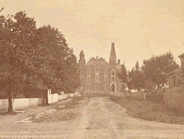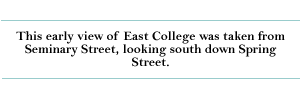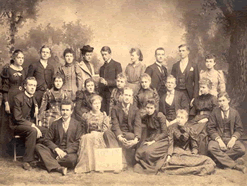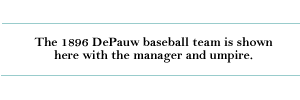
|
Pages: << Back 1 2 3 4 5 6 7 8 9 10 Next >> The
departmental structure of the university also expanded to reflect
the widening body of knowledge and more specialized subjects in
the modern curriculum. Latin and Greek remained important departments,
but modern languages were divided into departments of German and
the Romance languages. Separate departments emerged for oratory
and for rhetoric and English literature. Mental and moral philosophy
became simply philosophy, and Biblical literature was renamed the
English Bible, which was required of all students. Joining chemistry
and physics as independent departments were botany and zoology,
formerly united in the department of biology. Astronomy was separated
from mathematics and history from political science, though the
latter still included work in sociology and economics.
There was also a continuing secularization of the faculty. Except for the president himself and holders of the chairs in philosophy and Bible, DePauw professors were no longer expected to be ordained clergymen, though most were presumably Methodist church-goers. After long student agitation against the compulsory Sunday afternoon faculty lectures, the John administration first reduced their frequency and finally eliminated them altogether. A revolution in teaching methods took place at this time with the disappearance of the daily class recitations, so long a fixture in American college education. Their place was taken by classroom lectures, laboratory exercises, and library research assignments. Professors Edwin Post in Latin, James R. Weaver in political science, and Andrew Stephenson in history conducted German-style seminars for advanced students, and the latter two established departmental library-laboratories funded by student fees. The chemistry laboratory in the East College basement and the physics and biological laboratories in Middle College began to be furnished with increased amounts of equipment, enabling them to play a much larger role in education in the natural sciences. Organized sports were beginning to find an accepted place in the early DePauw years, though with little official encouragement. In 1890 students organized an athletic association with the help of a few faculty members to support varsity teams in baseball and football. At the same time DePauw joined with Indiana, Purdue, Butler, Wabash, and Rose Polytechnic to form the Indiana Intercollegiate Athletic Association under the auspices of the state YMCA. The next year the faculty voted strict eligibility rules for participating athletes and appointed a special committee to oversee intercollegiate competition.
At
first the lack of a suitable playing field hampered all such efforts.
Banned from the campus proper by the administration, varsity teams
resorted to a rough field west of the city beyond the Monon Railroad
tracks. After a long campaign by students and faculty to obtain
better facilities closer to campus, land was purchased on West Hanna
Street in 1895 for McKeen Field, named for the president of the
Vandalia Railroad, W.R. McKeen, who made the first major contribution
to the project. It was formally dedicated in October of that year
with a football victory over Indiana
University. |
Depauw University e-history | E-mail comments to: archives@depauw.edu





